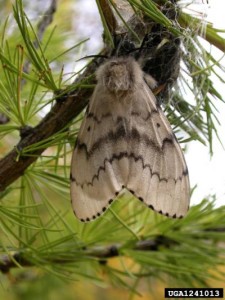The Asian gypsy moth would be more damaging than the European gypsy moth because it feeds on a wider range of plants – including conifers – and the female flies – speeding up its spread.
 Asian gypsy moth; John H. Ghent; bugwood.org
Asian gypsy moth; John H. Ghent; bugwood.org
The United States and Canada have a joint program – under the auspices of the North American Plant Protection Organization (see RSPM #33 here) aimed at preventing introduction of species of gypsy moths native to Asia. The principal risk arises from moths attaching their egg masses to ships (and containers on deck) when the ships visit ports in Far Eastern Russia, China, Korea, and Japan. The NAPPO standard originally went into force in March 2012. Under its terms, ships leaving ports in those countries during gypsy moth flight season must be inspected and cleaned before starting their voyage.
Gypsy moth populations rise and fall periodically; thus, it is much more likely that egg masses will be attached to ships during years of high moth population densities.
These variations are seen in U.S. and Canadian detection reports.
AGM Interceptions by year
United States Canada
2010 4
2011 21
2012 44 32
2013 42 33
2014 76 39
2015 7 15
(U.S. data from Kevin Harriger, Bureau of Customs and Border Protection, at the 2015 meeting of the Continental Dialogue on Non-Native Forest Insects and Diseases [http://continentalforestdialogue.org/continental-dialogue-meeting-november-2015/] ; Canadian data from Wendy Asbil, National Manager, Invasive Alien Species and Domestic Plant Health Programs Section, Plant Health and Biosecurity Directorate, Canadian Food Inspection Agency
While most AGM detections are at West Coast ports, the risk is not limited to that region. In 2013, Asian gypsy moths were detected at Baltimore, MD; Charleston, SC; Savanna and Brunswick, GA; Jacksonville, FL; New Orleans, LA; Houston and Corpus Christi, TX; and McAlester, OK.
Well aware of the risk associated with ships, U.S. and Canadian customs officials are vigilant in conducting inspections; if egg masses are found, the ships are required to return to international waters and clean off the egg masses. The ships are inspected again before they are allowed back into port. The process delays deliveries that are often on tight schedules and costs hundreds of thousands of dollars.
However, the risk is not limited to the ships themselves. In 2014, more than 500 Asian gypsy moth egg masses were found on four shipments of imported steel slabs arriving at ports on the Columbia River. Efforts were made to clean the more than 5,000 steel slabs, but some egg masses were still present after the cleaning. The steel was then sent to a furnace for final processing; the furnace heated the steel to more than 2,000oF – sufficient to kill any remaining eggs! Still … (report by APHIS: Asian Gypsy Moth interceptions and mitigation of risk at Columbia River Ports of Entry, 2014. 18 February 2015)
Some question whether a global company with annual earnings close to $2 billion can be persuaded to take the necessary steps to ensure that its imports are free of gypsy moth eggs. The cleanup costs charged by APHIS would be minimal.
Besides, cleaning large steel plates is apparently difficult and probably requires fumigation with methyl bromide – which must be administered in a closed facility with appropriate safety measures.
Implementing the NAPPO standard that presents a unified front to Asian exporters – they must clean ships headed to North America – clearly has reduced the risk of introduction of Asian gypsy moths. But the smaller risk remains. Indeed, Oregon and Washington occasionally catch small numbers of Asian gypsy moths in their traps. In 2015, ten Asian gypsy moths were trapped in Washington State (Report of the Technical Working Group for the Response to Asian Gypsy Moth Captures Washington-Oregon 2015 October 30, 2015).
Oregon caught two Asian gypsy moths in the Portland area (15,000 traps had been placed statewide; the state also trapped 12 European gypsy moths). Previous detections of Asian gypsy moth in Oregon were one each in 1991, 2000, and 2006. Two of these moths were trapped near the location of the 2015 detections. A vessel that called at Tacoma in January 2013 had 275 egg masses.
The Asian gypsy moths were caught in traps across a broad area, including eight captures around southern Puget Sound and three in the Portland, OR/Vancouver, WA area. For these and other reasons, experts concluded that it is likely that females moths are also present in one or more of these areas (Report of the Technical Working Group for the Response to Asian Gypsy Moth Captures Washington-Oregon 2015 October 30, 2015).
The expert group recommended enhanced trapping plus eradication at the four sites where captures were clustered. The group discussed the pros and cons of various approaches, including spraying with Btk, Diflubenzuron (“Dimilin”), or Tebufenozide (“Mimic”); or with Gypchek (gypsy moth nuclear polyhedrosis virus); and augmentation of spray programs by releasing sterile males.
Both Washington and Oregon plan gypsy moth eradication measures in 2016. Washington plans to treat 10,500 acres at seven locations in Pierce and Thurston counties (both at the southern end of Puget Sound). Oregon will spray in several places in northern and northwest Portland.
Posted by Faith Campbell